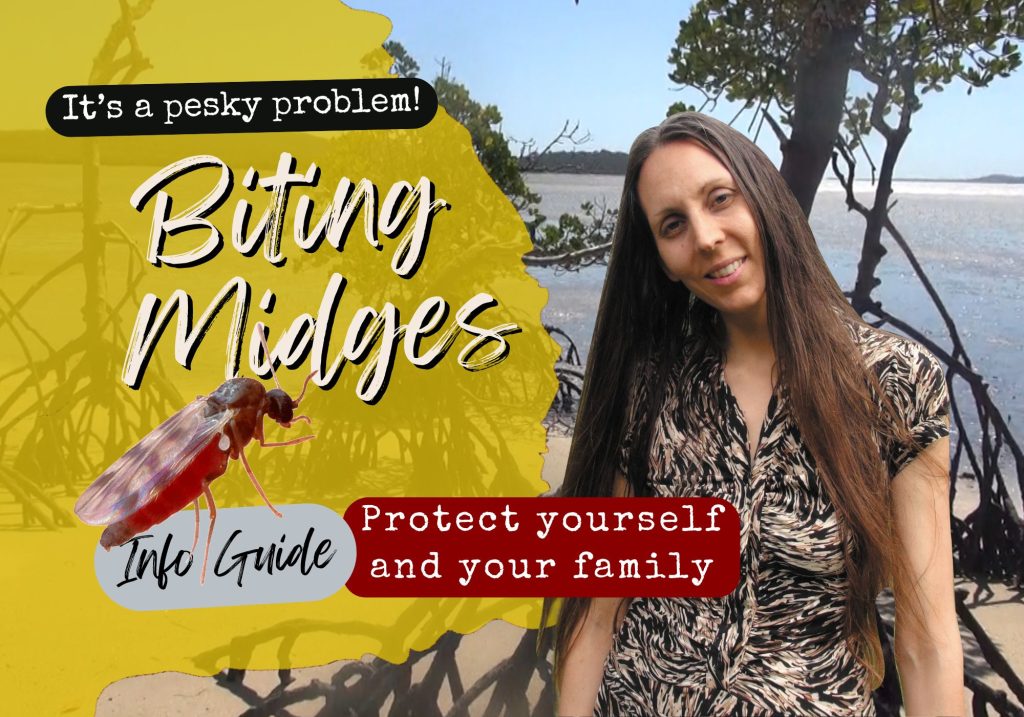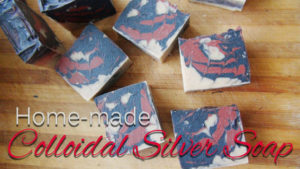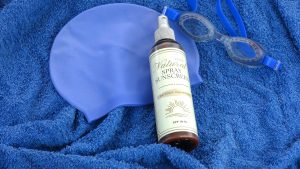Biting midges (also known as no-see-ums in North America) are a common issue in Australia and other parts of the world, except in the Antarctic and Arctic regions. They are known to be a nuisance and significant issue for tourists and residents. They are also named ‘punkies’ in Northeast America, “five-O’s (related to biting around 5 PM) in Florida and Alabama, “pinyon gnats” in the Southwest, and “moose flies” in Canada. 1
They are sometimes incorrectly referred to as sand flies. Sand flies are insects that belong to a different biological group and should not be confused with the biting midges. 16
They have been a nuisance to our family living on the coast of Qld, Australia. We have had to adapt and protect ourselves from these ‘small mosquitoes’, and especially during the warmer months. Keep reading to learn more about these insects, their preferences, and effective tips for protecting yourself and your family from these bloodsucking pests, especially if you live in a biting-midge prone area.
Biting midge facts
There are many different species of midge insects. Non biting midges look more like mosquitoes and are part of the Chironomidae family. Biting midges (or no-see-ums) on the other hand, are tiny flies that resemble tiny gnats. They are part of the Ceratopogonidae family with encompasses over 5000 species. They typically measure between 1 and 3 millimetres (1/16 to 1/8 inch) in length. 2
Biting midges are holometabolous insects, meaning they undergo complete metamorphosis to reach adulthood. The midge fly life cycle includes four stages: egg, larva, pupa, and imago or adult. The most common species will take 2-6 weeks to complete a life cycle. 3
Both adult males and females feed on nectar, but the females also feed on the blood of vertebrates (animals with a spine or backbone), including humans. They are similar to mosquitos because only the females bite and they require protein rich blood to develop and lay their eggs.
Their wings are grey in colour and their abdomen changes to red when they feed on a human or pet. They also have powerful mouthparts that allow them to open skin so they can draw blood. 4
They are attracted to carbon dioxide emitted through breathing, body heat, and certain odors. They are drawn to humans, animals, and other vertebrates. 5,6
Although biting midges are not typically known to transmit diseases to humans, their bites can result in intense itching, swelling, and redness. Some individuals may experience severe allergic reactions to the proteins in the midge’s saliva, potentially leading to more serious health issues. 7
They are given the name no-see-ums because they usually get away with biting you without you noticing. Even though they are almost invisible, especially when they are flying, their bites are very noticeable and irritating.
Are they a public health concern?
Biting midges, unlike mosquitoes, do not transmit diseases to humans but they can transmit diseases to animals. Specifically, the Culicoides species can transmit various pathogens. They are known to spread diseases such as parasitic nematodes (Mansonella), bluetongue disease (which affects livestock in North America), African horse sickness, epizootic hemorrhagic disease, arboviruses, and other nonviral animal pathogens. 8
Given their ability to transmit diseases to other living organisms, it’s prudent to stay vigilant and take measures to protect yourself and your family from bites as much as possible.
Can they be eradicated or controlled?
Eradicating biting midges is a complex and seemingly impossible task. Poisoning their larvae is ineffective due to their diverse habitats and life cycle. These insects breed and lay eggs in moist soil or water, thriving in various environments like mud and sandy substrates. This diversity makes population control extremely challenging. Additionally, they inhabit environmentally sensitive intertidal zones, and their dispersal patterns are not well understood.
Insecticide applications provide only short-term relief and repeat applications are needed. 9
The dark side of living in paradise: living with biting midges
Living near the coast of Qld is wonderful: picture postcard landscapes, and warm and sunny weather perfect for swimming most days. Many locals are fishermen here and being on the water is a frequent occurrence when you own your boat or yacht.
But there is also a dark side to the beautiful scenery here, one that is not frequently talked about by the locals or real estate agents. Living in a rural town that is surrounded by mangroves and tidal mudflats means we endure living with biting midges all year round. They are the most prevalent through the warmer months and we do get less of them in the wintertime. Our house is situated right behind the mangroves – the perfect estuarine environment for biting midges to thrive.
Little did we know this before moving here. Back in 2018, It was an excellent opportunity to buy a house near the beach as the prices were low. We were able to purchase our property outright. Besides these insects, we love living here. I have always dreamed of living near the beach as a child. The prices were good and the opportunity was just right at the time. We moved here from interstate NSW and were not told directly by the real estate agents about these blood-sucking parasites that also resided here – the biting midges or (no-see-ums).
We’ve tried numerous methods to protect ourselves and control these biting insects to avoid being bitten alive. Trust me, there have been times when we were covered in bites, especially during our initial visits to the house. Both arms would be completely bitten, turning red, bumpy, very itchy, and blotchy. Since we weren’t informed about the midges, we didn’t have any protection against them at first.

Living with two young children adds to the challenge, as we encourage them to spend hours outdoors. However, outdoor activities like sports or gardening become difficult due to the constant need for protection. Playing in the backyard means either wearing pants and long-sleeve tops or using repellent. Protective clothing is easier, but the kids often get too hot in the summer. We opt for light, breathable fabrics for this reason. Additionally, we only get a small window, from 11 am to 2 pm, to spend quality time outdoors when the midges are less active. They also bite pets, so it’s important to keep your pets indoors during peak midge activity times.
Being outdoors with biting midges is challenging, especially if you love gardening. Wearing full clothing in the heat and humidity can be uncomfortable, but it’s necessary. I’d rather be hot and flustered than covered in bites. These insects are so persistent that they’ll bite any exposed skin, including bare feet. Every part of your body needs to be covered, including socks and gloves when gardening.
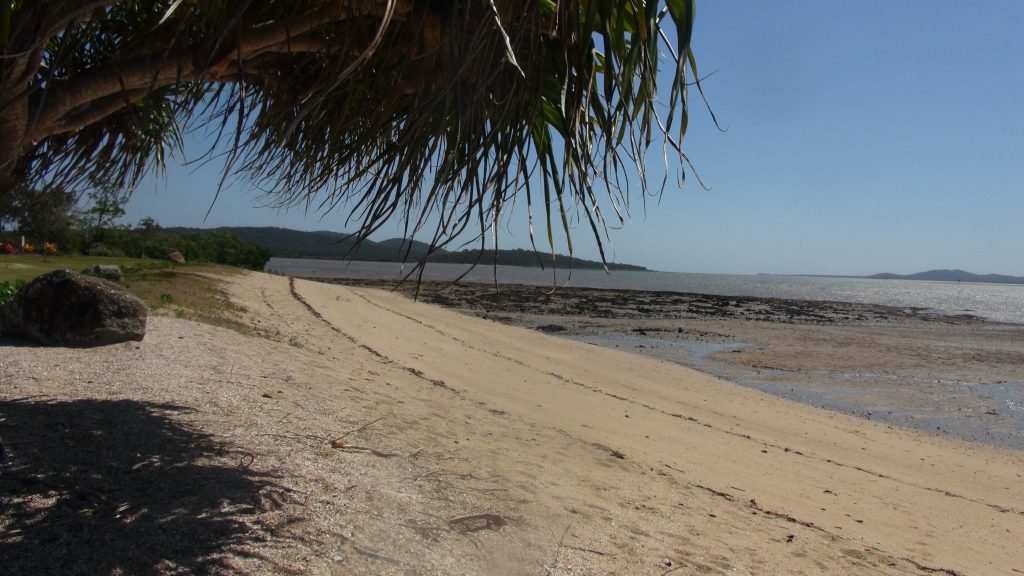
Alternatively, you could use repellent over your entire body, but even this doesn’t offer complete protection, especially during swarms. You’ll also need to reapply it frequently.
Using commercial repellents can be effective, but I try to avoid certain chemical sprays and lotions with DEET. Is DEET safe? Although many regard DEET as safe, there is controversy surrounding its use and its link to adverse neurological effects on human health. 10
The strong smell of sprays like Aeroguard can also be irritating, especially if you’re prone to asthma and allergies.
Over time, you get used to living with the bites and being in protection mode. You learn to manage them. Initially, the bites were very noticeable on my skin, but over time, it seems the body adapts and builds some immunity. The bites don’t become as easily infected anymore.
I have made and used a homemade insect repellant that works well enough. I’ve tried Dettol, olive oil, and essential oil mixed. It works well as an alternative to commercial products. It’s budget-friendly and easy to make.
Biting midge information
Travel distances
- Biting midges can be found in cities and residential areas, even if there isn’t a wetland nearby. This is because they can travel an average of 2-5 kilometers from their original site. Notably, the species Leptoconops kerteszi in the southwestern United States has been reported to travel up to 15 kilometers within 24 hours. 11
They like…
- Humid, warm and overcast conditions with minimal air movement.
- Natural detritus: damp leaf piles, rotting wood, and remnants of dead trees. The ideal conditions for propagation.12
- Dawn and dusk: Biting midges prefer dim light over bright light and are most active during these times. They often swarm and linger near doors, especially in the early morning, waiting to come inside. I frequently find them right by the door to my deck.
- They thrive in temperature ranges between 27°C and 32°C. 13
They don’t like…
- Strong winds: on windy days we do get a small respite. Keep fans on indoors to help keep them at bay.
- Strong light: they stay away from bright light, like full sun.
- Smoke: Close to our property, the fire brigade carries out burn offs before the warm weather hits. During this time, they lessen. I have also found they reduce when you burn incense or mosquito coils.
Tips to stay protected
- Run fans inside the house. Air conditioners are also effective in reducing humidity and temperature, which helps keep midges away.
- Cover your windows with protective fabric or fine mesh. Standard mosquito mesh has holes too large for midges, so use a finer mesh to prevent them from entering.
- Wear protective clothing, especially when you’re outdoors.
- Keep insect repellent handy for when you need to go outside.
- Eliminate stagnant water around your home (like in bird baths or pots) as midges breed in moist soil and water. Regularly maintain your swimming pool.
- Trim your lawn regularly since midges like to hide in tall grass and weeds.
- Does this help? Let me know if you need any more adjustments!
- Stay inside with your pets during dawn and dusk. These are peak times for biting midges.
- Avoid watering your garden during these periods to reduce attracting them.
- Opt for yellow bulbs for outdoor lighting, as midges are less attracted to yellow than white or blue light. 14
- Burn mosquito coils to reduce their numbers. Incense can also be effective.
- Use citronella candles to help keep midges at bay.
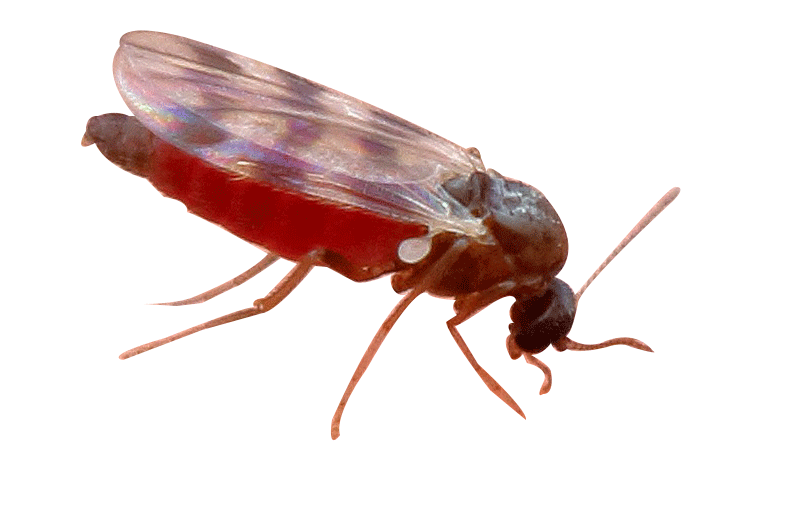
Tips for after care
In general, midge bites should last around 24-48 hours, depending on your sensitivity. It’s important to resist the urge to scratch, as this can lead to infection and prolong the healing process. I’ve experienced this myself many times initially. Instead, it’s better to gently wipe your skin with your hand to remove the midge and reduce some of the irritation after being bitten.
Here are some natural tips to soothe the itch and disinfect midge bites:
- Wash the bites with warm soapy water, then apply a hot washcloth to the area for 10 minutes.
- Disinfect with diluted hydrogen peroxide (mix equal parts water and peroxide), and wash off after 2 minutes. 15
- Apply an ice pack or rub an ice cube around the affected area to soothe itchiness.
- Use aloe vera gel on the affected areas. Learn more about aloe vera and its uses in my informational post here.
- Try colloidal silver to disinfect the area. Check out my post on colloidal silver and the generator I use to make my own at home here.
- Consult a physician if the itchiness persists or worsens.
Conclusion
Biting midges can be a persistent nuisance for both residents and tourists. Living with them requires some know-how and taking protective measures to avoid bites and reduce their population. Making your own natural repellant is a good idea, especially when you need to use them frequently. If living or traveling in an area with biting midges is a concern for you, always do your due diligence before buying property or planning a trip.
Do you have biting midges in your area? How do you protect yourself from their bites when traveling? Share any tips and experiences below and let us know if you have a good DIY repellant recipe that works well for you.
Source:
1,3,8. Ceratopogonidae – Wikipedia
6,7,14. Biting Midges: How to Avoid and Treat Their Bites – Knowledge Voyager
9. 2024-2025 Biting Midges Fact Sheet – Sunshine Coast Council
11,12. Where Do Midges Live? A Look at Biting and Non-Biting Midges (midgeeducation.com)
13. First Aid for Biting Midges (australiawidefirstaid.com.au)
15. Treating Insect Bites | Ask Dr. Sears® (askdrsears.com)
16. biting midges, no-see-ums, Culicoides spp. (ufl.edu)

